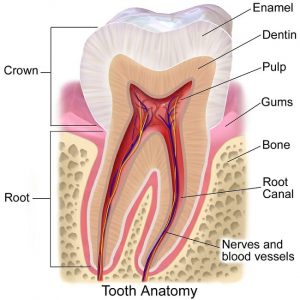Teeth Definition
Teeth are hard, mineral-rich structures which are used to chew food. They are not made of bone like the rest of the skeleton, but have their own unique structure to enable them to break down food.
Tooth enamel is the most mineralized tissue in the body, consisting mainly of the rock-hard mineral hydroxyapatite. Hydroxyapatite is also found in some rocks and makes up part of the mineral/protein matrix of bones.
Some animals have the ability to replace their teeth throughout their lifespan, as teeth may be lost due to injury or disease. Humans have two sets of teeth: baby teeth which loosen and fall out prior to adulthood, and adult teeth which stay in place throughout adult life.
The shape and number of an animal’s teeth vary according to what they eat. Here we’ll discuss the functions of different types of teeth, as well as the structure and different tissues which make up human teeth.
Function of Teeth
Teeth assist animals in obtaining food and breaking it down for efficient digestion. Animals who lose their teeth are generally unable to ingest enough nutrients to survive.
The specific mechanical functions that teeth must perform depends on the animal’s food source. The animal may need to pierce skin and tear meat, grind up fibrous vegetables, or do some combination of the two.
Predators often boast sharp, pointed or even serrated teeth to assist them in taking down prey and eating raw meat.
Herbivores on the other hand typically have long, sharp incisors at the front of their mouths to assist in cutting bite-sized pieces off of plants and well as molars with broad, textured surfaces in the back of the mouth which grind and break down plant matter for easier digestion by the stomach.
Humans eat both meat and a variety of plant matter. As a result, we have several types of teeth which are good for breaking down different types of food:
- Front teeth, or incisors, which cut food into bite-sized chunks.
- Sharp, pointed “canine” teeth, which can be used to tear chunks off of meat and other foods.
- Molars and pre-molars which crush vegetable matter and other foods into a pulp.
Structure of the Tooth
The structure of a human tooth includes the following tissues:
- Enamel – The hard, calcified outer covering which is used to break down food. Enamel consists primarily of a matrix of hydroxyapatite – a mineral made of crystalline calcium phosphate which is created by the body’s cells during tooth development. Hydroxyapatite can also be found in some rocks, and in the mineral/protein matrix that makes up the hard outer shells of our bones.
- Dentin – A softer, more vulnerable material which serves as a last line of defense for the tooth pulp in the event that enamel is broken or dissolved.
- Cementum – a bone-like tissue that includes both hydroxyapatite and connective proteins. This tissue attaches the tooth to the periodontal ligaments, which hold the tooth firmly in place within the jawbone.
- Pulp, which contains blood vessels and nerves used to keep the tooth healthy and alert the organism to dangerous tooth injuries and infections.
The tooth is often broken down by dentists into the following major regions:
- The root, which consists of dentin and pulp, with a covering of cementum that anchors the tooth to the jaw. The root is especially vulnerable to injury and infection because it lacks protective enamel.
Infections of the tooth’s root can spread into the bloodstream or the surrounding jaw and tissues, which is why infections of a tooth’s root require prompt and thorough medical attention. - The neck, which is the place where the cementum of the root meets the enamel of the tooth’s crown. The root has a thin layer of enamel and a thick layer of dentin protecting the root.
- The crown, which consists of a thick enamel surface that is used to cut and grind food. A thick layer of dentin lies under the enamel, between it and the pulp of the tooth.
Quiz
1. Why is it important to floss?
A. To prevent potentially dangerous bacteria from reaching the root of the tooth.
B. To prevent bacteria from eating away at the enamel of the tooth’s neck and crown.
C. To prevent infections from spreading from the tooth to other parts of the body.
D. All of the above.
2. What is likely the diet of an animal with sharp, shearing incisors in the front of the mouth and flat, grinding molars in the back?
A. A carnivorous diet of meat.
B. An omnivorous diet with both plants and meat.
C. A herbivorous diet of plants.
D. None of the above.
3. What is one possible consequence of injury or infection to a wild animal’s teeth?
A. The infection may spread to other parts of the body, potentially resulting in death.
B. The animal may not be able to ingest enough nutrients to survive.
C. In some species, the teeth may be replaced by a new set of teeth.
D. All of the above.
References
- Romer, A. S., & Parsons, T. S. (1990). The vertebrate body. Fort Worth: Harcourt Brace Jovanovich College Publ.
- Clemente, C. D. (2011). Anatomy: a regional atlas of the human body. Philadelphia: Wolters Kluwer/Lippincott Williams & Wilkins Health.
- Dental Cervix – National Library of Medicine – PubMed Health. (n.d.). Retrieved July 17, 2017, from https://www.ncbi.nlm.nih.gov/pubmedhealth/PMHT0025298/
Teeth

No comments:
Post a Comment